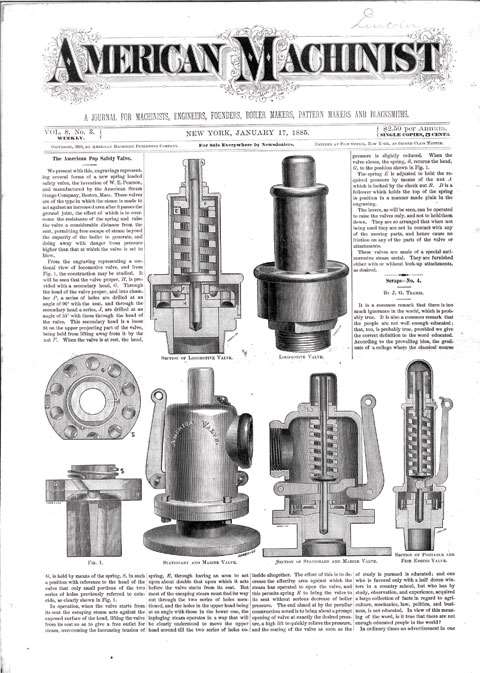A History Made in Metal
Today’s valve material choices are like a Chinese buffet: Everything imaginable is on the menu.
#valvehistory #materials
The first Roman valves were made from a bronze alloy very similar to today’s ASTM B62 bronze chemistry. These valves were used in plumbing systems in houses and public buildings. The bronze valves and other engineering discoveries of the Roman period would disappear under the thick cloak of the dark ages, and it wasn’t until the steam era that valve materials became a topic of interest again.
The first decade of the 20th century saw the introduction of cast steel as a valve material. Improvements in steel-making processes brought steel casting capabilities to the plant floor of the major valve manufacturers. Although steel valves were available during the early part of the century, iron and bronze still were the most popular valve materials.
THE TRIM
The materials for valve trim or “trimmings” as it was called a century ago were limited as well. Valve stems, seats and discs were made of bronze, brass or iron. The first improvement in trim materials was the introduction of copper-nickel alloys, essentially Monel. This “Monel metal,” as it was called, was very useful because it was harder than anything yet available and also highly corrosion resistant.
The next valve-trim material to gain popularity was Martensitic, 400 series stainless steel. These alloys were highly durable because of their ability to be heat-treated into an extremely hard condition. The 400 series stainless steels, by virtue of the 11-13% chrome content, also were corrosion resistant, and they would be the trim material of choice for 30-40 years until supplanted by cobalt-based “Stellite” materials after World War II.
As the temperatures and pressures increased in the power industry in the 1920s and 1930s, a need arose for higher performance cast steel. The carbon-moly steel alloy was a stopgap that raised the continuous operating temperature of steel valves to 850° F(454° C). Although the carbon-moly steel was useful at higher temperatures, it suffered from creep problems. The pre-WWII period also saw the introduction of the first austenitic stainless-steel alloys (304ss and 316ss), which were vastly superior to the 400 series in corrosion resistance.
Additional alloy steels made their debut as valve materials during the decade following WWII. The chrome/moly steels helped to raise the operating temperatures of cast steel valves above the 1000° F (538° C) range; 1-1/4 Cr. (WC6), 2-1/4 Cr. (WC9), 5 Cr. (C5) and 9 Cr. (C12) were all developed during this period. The first ASTM standard to address these materials was ASTM A157, Alloy Steel Castings for Valves, Flanges and Fittings for High Temperature Service, which was issued in 1950. This standard would later be superseded by ASTM A217. All these alloys also are produced as forgings, with most listed in the ASTM A182 material standard.
Twenty-first century valve manufacturers are still using the popular metals of the past 150 years, but newer materials are always under development. The latest alloy steel to attain great popularity is the “super 9 chrome” C12A cast steel and F91 forged steel, which allow for valve working temperatures of 1200° F (649° C), while providing better creep resistance than C12 material.
PACKING IT IN
Valves that have shafts or stems that move in and out of the pressure envelope require a packing to keep the pressure contained inside the valve. These packings must be flexible, reasonably resilient and able to withstand the highest temperature the valve will see in service. Early packing materials were rope derivatives such as jute and flax. But as operating temperatures rose, these materials proved inadequate. The answer was found in a unique mineral called Chrysotile, which gave us asbestos.
The long fibers of asbestos combined with its temperature resistance made it an outstanding packing and gasket material. Asbestos packing was installed in virtually all commodity steel valves from the 1920s through the 1980s. The material was superior for forming and filling the packing or stuffing box area, and it provided an excellent seal. Unfortunately, some of the same characteristics that made asbestos good packing, such as its fiber shape and size, also made it an unwelcome resident in the human lung. Since virtually every valve manufacturer used asbestos packings or gaskets, all of them have been drawn into lawsuits involving asbestos litigation and mesothelioma.
The replacement of asbestos packing and gaskets took some time, as immediate replacement materials did not work well. Finally, the industry perfected carbon/graphite-based products that have now been the norm for nearly 25 years when high-temperature packing and gasket materials are required.
For low-temperature applications, Teflon is an excellent corrosion-resistant sealing material. Teflon packing and gaskets are standard in today’s nickel alloy and stainless-steel valves. Teflon is also used for other valve components such as ball valve seats. The history of Teflon and ball valve seats is itself an intriguing tale but that tale is for another article.
GREG JOHNSON is president of United Valve (www.unitedvalve.com), Houston, and is a contributing editor to Valve Magazine. He serves as chairman of VMA’s Education & Training Committee, is a member of the VMA Communications Committee and is president of the Manufacturers Standardization Society. Reach him at greg1950@unitedvalve.com.
RELATED CONTENT
-
VMA Looks Back at 2012 and Forward to 2013
Contrary to dire predictions, the end of the Mayan calendar signaled only the end of one cycle and the beginning of another, while the end of 2012 signaled the end of another banner year for the Valve Manufacturers Association and the beginning of an exciting 2013.
-
The Intriguing Story of the Pressure Seal Valve
In a quest for more efficient power generation, power plants in the 1930s pushed the pressure-temperature envelope.
-
A History of the U.S. Valve Industry in World War II
From time to time ValveMagazine.com will open up the archives and re-publish some of our most popular articles from years past.












 Unloading large gate valve.jpg;maxWidth=214)